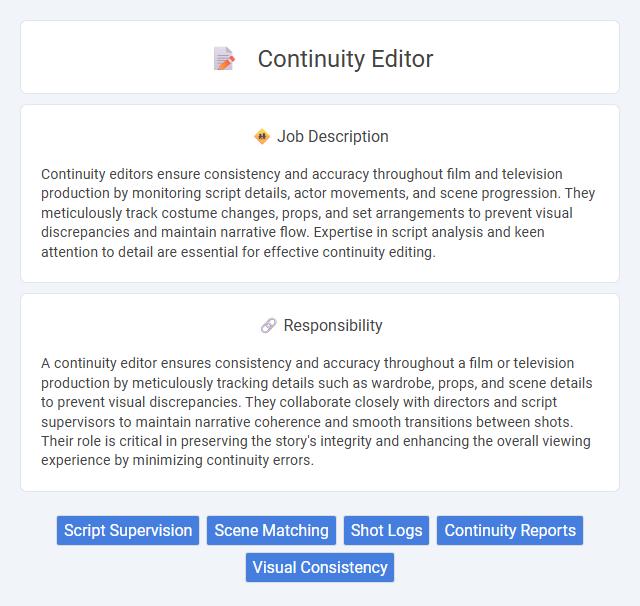
Continuity editors ensure consistency and accuracy throughout film and television production by monitoring script details, actor movements, and scene progression. They meticulously track costume changes, props, and set arrangements to prevent visual discrepancies and maintain narrative flow. Expertise in script analysis and keen attention to detail are essential for effective continuity editing.
People with strong attention to detail and excellent organizational skills are likely to be suitable for a continuity editor job. Those who thrive under pressure and can maintain focus during long hours on set or in the editing room may have a higher probability of success. Individuals who struggle with multitasking or have difficulty managing complex information flows might find this role challenging.
Qualification
A Continuity Editor requires a keen eye for detail and exceptional organizational skills to ensure consistency in scripts, scenes, and visual elements throughout production. Proficiency in script analysis, strong communication abilities, and a thorough understanding of film and television production processes are essential qualifications. Experience with editing software and the ability to collaborate closely with directors and script supervisors enhance a Continuity Editor's effectiveness.
Responsibility
A continuity editor ensures consistency and accuracy throughout a film or television production by meticulously tracking details such as wardrobe, props, and scene details to prevent visual discrepancies. They collaborate closely with directors and script supervisors to maintain narrative coherence and smooth transitions between shots. Their role is critical in preserving the story's integrity and enhancing the overall viewing experience by minimizing continuity errors.
Benefit
A continuity editor likely improves film or television production quality by ensuring consistency across scenes, which can reduce costly reshoots and save time. Their role may increase efficiency on set, contributing to smoother post-production processes. Hiring a continuity editor probably leads to a more polished final product, enhancing audience satisfaction and boosting project reputation.
Challenge
The role of a continuity editor likely involves meticulous attention to detail to ensure consistency across various aspects of a production, which can pose significant challenges. They probably face difficulties in tracking subtle discrepancies in script, props, and actor positioning that could disrupt narrative flow. The demanding nature of maintaining seamless continuity suggests this job requires strong observational skills and the ability to manage complex information under time pressure.
Career Advancement
Continuity editors play a crucial role in maintaining consistency and accuracy throughout the production process, enhancing their value in film and television projects. Gaining expertise in camera angles, script supervision, and visual storytelling opens pathways to roles such as assistant director or production coordinator. Strong attention to detail and collaboration skills support career growth into senior editorial positions or project management within media production companies.
Key Terms
Script Supervision
Script supervision plays a crucial role in a continuity editor's responsibilities, ensuring that all scenes maintain consistent visual and narrative elements throughout production. This position involves meticulous tracking of script details such as dialogue accuracy, character positioning, props, and wardrobe to prevent continuity errors. Effective script supervision guarantees smooth editing and seamless storytelling that align with the director's vision.
Scene Matching
A Continuity Editor ensures seamless scene matching by verifying consistency in visual and narrative elements across shots, including props, wardrobe, lighting, and character positions. This role demands acute attention to detail to maintain narrative flow and avoid jarring discrepancies that disrupt audience immersion. Mastery in scene matching contributes significantly to the overall production quality and viewer experience.
Shot Logs
A Continuity Editor specializes in maintaining detailed shot logs that document every take, angle, and scene element to ensure visual and narrative consistency throughout production. These shot logs serve as critical references during post-production for editors to match continuity seamlessly and streamline the editing process. Expertise in organizing, timestamping, and annotating shot details enhances collaboration between the directing and editing teams, reducing reshoot needs and ensuring a cohesive final product.
Continuity Reports
Continuity editors meticulously track scene and dialogue consistency to create detailed Continuity Reports that ensure seamless visual and narrative flow throughout a production. These reports document shots, props, wardrobe, and actor movements, preventing errors and saving reshoot costs. Effective Continuity Reports are essential tools for directors, cinematographers, and editors maintaining coherence across multiple shooting days.
Visual Consistency
A Continuity Editor ensures visual consistency across all scenes in film and television productions by meticulously monitoring costume, props, lighting, and set details. Their role is critical in maintaining seamless transitions between shots, preventing discrepancies that disrupt viewer immersion. Mastery of detailed observation and effective communication with the production team supports a coherent visual narrative throughout the project.
 kuljobs.com
kuljobs.com